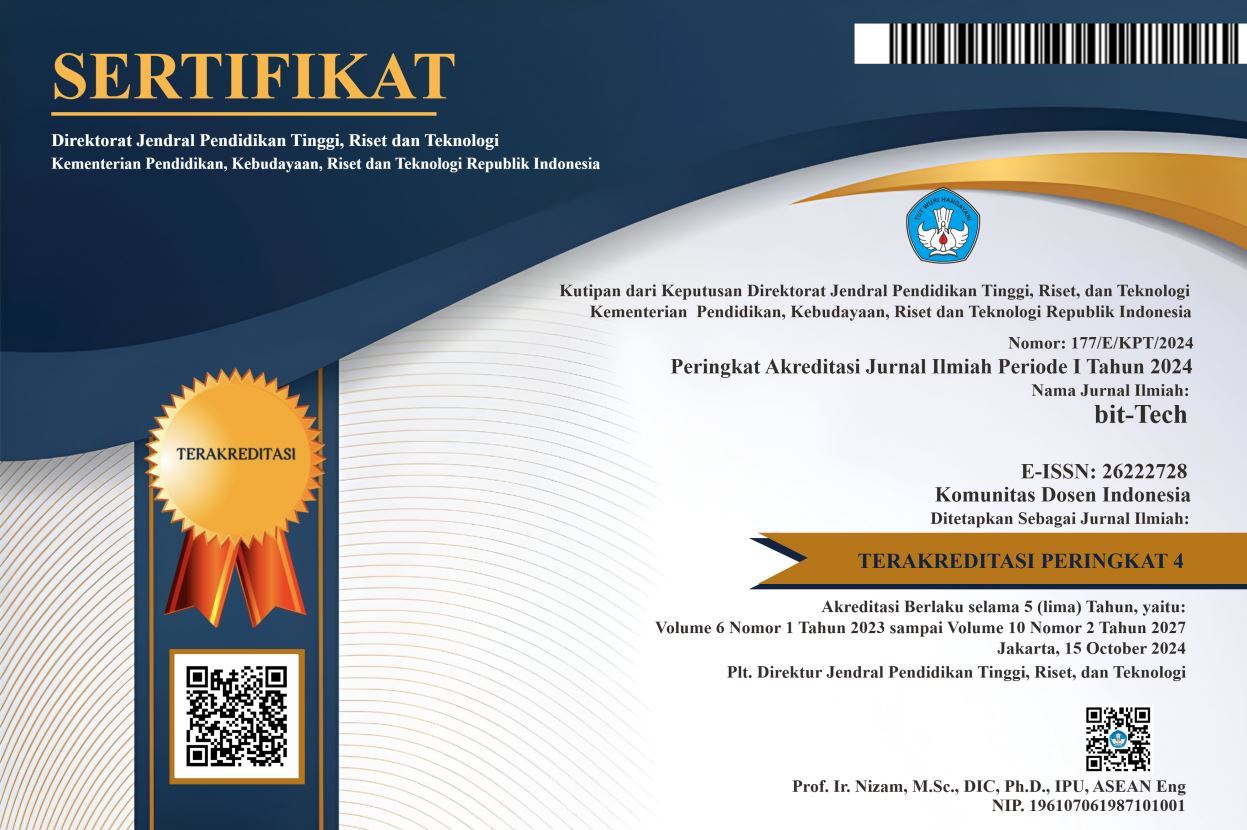Information System Web Design For Class English Proficiency Test Using Fisher Yates Shuffle Method
DOI:
https://doi.org/10.32877/bt.v5i3.724
Keywords:
English Proficiency Test (EPT) , Fisher-Yates Shuffle , Five Ascpect Quality , Random Exam Test , User Acceptance Test (UAT)
Abstract
Information technology has been rapidly developing over the past few decades, and the COVID-19 pandemic has further accelerated the adoption and implementation of technology in various aspects of our lives, particularly in the business sector and education., where improvements in the learning system that were originally offline become online, practical, and easy. Currently, information regarding the English Test at Faculty of Social Sains and Humanities Buddhi Dharma University (UBD) is still running manually starting from registration, scheduling, exam, and announcement of English test results which of course requires more time for both participants and faculty staff. In order to boost students English knowledge, an English comprehension exam test is needed as organized by the faculty, that is English Proficiency Test (EPT). The design of this EPT information system, a part of being able to change the manual method, and also to simplified the EPT procedure. The new system is using website which combined with Fisher-Yates Shuffle method for randomization the exam test to reduce fraudulent actions in the process of conducting English training tests, being followed by 94 respondents as English training participants, system tested using the User Acceptance Test (UAT) method with five aspects of quality components. The results obtained that the system built had a good criteria with a value of 75.93%.
Downloads
References
I. Witado and Marhalim, “Penerapan Linear Congruent Method Sebagai Media Pembelajaran Reproduksi Remaja Berbasis Android Untuk Pembelajaran Biologi,” SAINTIK: Jurnal Sain Informatika, Sistem dan Teknologi Informasi, vol. I, no. 1, p. 38119, 2021.
I. Maryono, W. B. Zulfikar, and R. Kariadinata, “The implementation of fisher yates shuffle on aljabar learning media based on hybrid application,” in MATEC Web of Conferences, EDP Sciences, Sep. 2018. doi: 10.1051/matecconf/201819701006.
I. Febriani, R. Ekawati, U. Supriadi, and M. I. Abdullah, “Fisher-Yates shuffle algorithm for randomization math exam on computer based-test,” in AIP Conference Proceedings, American Institute of Physics Inc., Apr. 2021. doi: 10.1063/5.0042534.
F. Natchiar Mohd Khaja and A. Ghani Abu, “A Preliminary Study on the Barriers in Listening Section of English Proficiency Test: Students’ Perspectives,” DIDAKTIKA (Jurnal Pemikiran Pendidikan), vol. 28, Feb. 2022.
B. D. Meilani and M. ’ Ailik, “APLIKASI RANDOM BANK SOAL UJIAN NASIONAL SEKOLAH DASAR MENGGUNAKAN METODE LINEAR CONGRUENTIAL GENERATORS (LCG),” Seminar Nasional Sains dan Teknologi Terapan IV, 2016.
V. Hegde, S. T. D, and L. S, “Randomized Online Question Paper Generation through SQL query and JEE,” International Journal of Innovative Technology and Exploring Engineering (IJITEE), vol. 8, no. 8, pp. 1438–1442, 2019.
S. Boonsathorn, “Computer-Based Test of English Competence (CB TEC) for EFL Advanced Learners: A New Format of C-Test,” IEEE, 15th International Conference on Information Technology Based Higher Education and Training (ITHET), 2016, doi: 10.1109/ITHET.2016.7760716.
F. Makmur, B. Daniawan, and A. Wijaya, “Computerized Semester Exams by Randomization Order of the Questions with Linear Congruential Generator Methods (Study Case: Agathos Vocational High School),” Bit-Tech, vol. 1, no. 3, 2019, [Online]. Available: http://jurnal.kdi.or.id/index.php/bt
M. Irfan, D. R. Ramdhania, I. S. Nita, T. Priatna, and A. R. Atmadja, “Design and build an early childhood puzzle educational game using the fisher-yates shuffle algorithm as an android-based scrambler for snippets,” in IEEE, Proceedings - 2020 6th International Conference on Wireless and Telematics, ICWT 2020, Institute of Electrical and Electronics Engineers Inc., Sep. 2020. doi: 10.1109/ICWT50448.2020.9243628.
A. Fairuzabadi and A. A. Supianto, “CoMiG: a Color Mix Game as a Learning Media for Color Mixing Theory,” IEEE, 2018 International Conference on Sustainable Information Engineering and Technology (SIET), pp. 197–201, 2018, Accessed: Apr. 18, 2023. [Online]. Available: https://ieeexplore.ieee.org/document/8693166
M. Risnasari, M. A. Effindi, P. Dellia, L. Cahyani, N. Aini, and N. Aini, “Computer Based Test Using the Fisher-Yates Shuffle and Smith Waterman Algorithm,” International Conference on Art, Design, Education and Cultural Studies (ICADECS), vol. 2021, pp. 353–360, Jun. 2021, doi: 10.18502/kss.v5i6.9224.
Rahmiati, R. Melyanti, D. Suryani, and Ambiyar, “Mobile Game Education About using Capitals Hiragana and Katakana Fisher-Yates Shuffle Algorithm and Fuzzy Tsukamoto,” International Journal of Management and Humanities, vol. 5, no. 9, pp. 30–34, May 2021, doi: 10.35940/ijmh.I1315.055921.
M. Tayel and G. Dawood, “Block Cipher S-box Modification Based on Fisher-Yates Shuffle and Ikeda Map,” 2018 18th IEEE International Conference on Communication Technology, pp. 59–64, Oct. 2018, doi: 10.1109/ICCT.2018.8600161.
A. T. Huynh, “Randomness is hard: learning about the Fisher-Yates shuffle algorithm & random number generation,” medium, Jul. 26, 2018. https://medium.com/@oldwestaction/randomness-is-hard-e085decbcbb2 (accessed Apr. 17, 2023).
F. Panca Juniawan, H. Arie Pradana, Laurentinus, and D. Yuny Sylfania, “Performance comparison of linear congruent method and fisher-yates shuffle for data randomization,” in IOP Conf. Series: Journal of Physics: Conf. Series 1196 (2019) 012035, Institute of Physics Publishing, Apr. 2019, pp. 1–8. doi: 10.1088/1742-6596/1196/1/012035.
A. Yulianto, A. Pudjitriherwanti, and C. Kusumah, “Delineating Discrepancies between TOEFL PBT and CBT,” International Journal of Language Testing, vol. 13, no. 1, 2023.
Elizabeth, “Fisher-Yates Shuffle: Randomly Shuffle a List in-Place,” medium, Nov. 21, 2019. https://emctackett.medium.com/fisher-yates-shuffle-randomly-shuffle-a-list-in-place-30a05b05a9cb (accessed Apr. 17, 2023).
Omar Rashid, “Fisher-Yates Shuffle,” medium, Jun. 05, 2019. https://medium.com/@omar.rashid2/fisher-yates-shuffle-a2aa15578d2f (accessed Apr. 17, 2023).
Jakob Nielsen, “Usability 101: Introduction to Usability,” nngroup, Jan. 03, 2012. https://www.nngroup.com/articles/usability-101-introduction-to-usability/ (accessed Apr. 17, 2023).
R. Agustina and D. Suprianto, “Analisis Hasil Pemanfaatan Media Pembelajaran Interaktif Aljabar Logika Dengan User Acceptance Test (UAT),” SMATIKA Jurnal , vol. 08, no. 02, pp. 67–73, 2018.
D. Wijaya, B. Daniawan, and Y. Gunawan, “Search Engine Optimization (SEO) As A Promotional Media On Google Search,” Bit-Tech, vol. 4, no. 1, 2021, [Online]. Available: http://jurnal.kdi.or.id/index.php/bt
Downloads
Published
How to Cite
Issue
Section
License
Copyright (c) 2023 bit-Tech

This work is licensed under a Creative Commons Attribution-ShareAlike 4.0 International License.
I hereby assign and transfer to bit-Tech all exclusive copyright ownership rights to the above work. This includes, but is not limited to, the right to publish, republish, downgrade, distribute, transmit, sell, or use the work and other related materials worldwide, in whole, or in part, in all languages, in electronic, printed, or any other form of media, now known or hereafter developed and reserves the right to permit or license a third party to do any of the above. I understand that this exclusive right will belong to bit-Tech from the date the article is accepted for publication. I also understand that bit-Tech, as the copyright owner, has sole authority to license and permit reproduction of the article. I understand that, except for copyright, any other proprietary rights associated with the work (e.g. patents or other rights to any process or procedure) must be retained by the author. In addition, I understand that bit-Tech permits authors to use their papers in any way permitted by the applied Creative Commons license.


 DOI :
DOI :
 Abstract views: 204
/
Abstract views: 204
/  PDF downloads: 195
PDF downloads: 195











